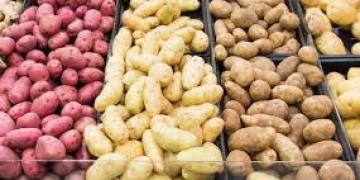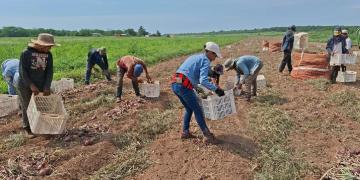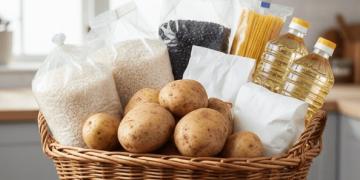Información Técnica: Growing smarter potatoes’: The emerging influence and potential impact of generative AI on the potato industry
Throughout history, the relentless pursuit of innovation has propelled agriculture forward. Today, we find ourselves amidst a new technological wave driven by the remarkable capabilities of the so-called generative artificial intelligence (AI).

This branch of AI breaks the mold of traditional systems that focus primarily on pattern recognition.
Generative AI’s capacity to learn, synthesize complex information, and create novel solutions introduces unprecedented opportunities to optimize global food production, ensuring the health and longevity of vital food sources like the potato.
What’s the big buzz about GenAi and potato farming?
Imagine you have a farmer friend who’s really good at growing potatoes. This friend has spent years learning everything about potatoes: which types grow best in which soils, how weather affects their growth, and how to deal with pests and diseases. Now, imagine if this friend could create a super helpful guide for growing the best potatoes based on all that knowledge.
Generative AI in potato farming is like this super knowledgeable farmer, but in the form of advanced technology. It learns from loads of data related to potato farming – things like different potato varieties, soil conditions, climate patterns, and common potato diseases. After studying all this information, the AI can then come up with new ideas and solutions to help grow potatoes better.
For example, it might analyze data from many potato farms and figure out the best planting methods for a specific type of soil. Or it could look at weather patterns and tell farmers the best time to plant or harvest. It could even examine lots of pictures of potato plants, learn to recognize early signs of disease, and then alert farmers before the problem gets too big.
In simple terms, generative AI for potato farming is like a highly experienced, super-smart farming assistant that can offer advice, generate new farming strategies, and come up with creative solutions to make sure the potatoes grow well and the farm stays healthy.
What’s on offer?
The potato, a remarkably versatile and nutritionally dense crop, plays a critical role in feeding billions worldwide. As demands on potato production escalate, generative AI can become an indispensable tool for farmers. Its power to analyze vast datasets on potato genetics, pest and disease patterns, climate variability, and consumer demands can usher in a new era of intelligent potato farming.
Generative AI promises to enhance potato breeding programs, fostering the development of varieties resistant to devastating diseases and adaptable to changing environmental conditions. With its ability to forecast localized crop yields, water, and nutrient needs, generative AI promotes hyper-efficient resource allocation, maximizing harvests while safeguarding the environment. Moreover, its insights into market trends and shifting consumer preferences can enable farmers to make informed planting decisions, aligning production with demand and optimizing their economic returns.
The integration of generative AI into the potato industry is not merely about technological advancement; it’s an act intrinsically linked to the future of food security. As the world’s population grows and climate change alters traditional growing patterns, generative AI stands to become a powerful force in ensuring that humanity can continue to sustainably and efficiently cultivate this vital food source.
Generative AI technologies are not just futuristic concepts but are increasingly becoming a part of the present reality in potato farming. While some of these innovative applications that we mention in this article are already in practice, enhancing efficiency and productivity on the farms, others represent exciting advancements on the horizon. For instance, AI-driven pest and disease detection, as well as yield prediction models, are already being employed by forward-thinking farmers, harnessing the power of data to make informed decisions. These existing applications are proving their worth by reducing costs, minimizing environmental impact, and boosting crop quality.
On the other hand, more sophisticated uses of generative AI, such as advanced genetic breeding for disease resistance and complex market demand forecasting, are rapidly evolving and hold the promise of revolutionizing potato farming in the near future. Thus, while we witness the tangible benefits of these technologies today, we also stand on the cusp of more profound changes that are set to redefine the agricultural landscape
With this understanding of how generative AI functions as an innovative and intelligent tool in agriculture, let’s delve deeper into its revolutionary impact on potato farming, exploring just a few examples of its myriad applications and the transformative possibilities it brings to the field, in no particular order of importance.
Precision Breeding for Disease and Pest Resistance
Concept: Generative AI’s ability to parse through extensive genetic and environmental datasets allows for the creation of highly specialized potato breeds. This includes not just resistance to prevalent diseases like late blight but also adapting to local environmental stressors such as soil type or climate conditions, thereby improving overall adaptability and yield.
Explanation: This accelerated breeding process, enabled by AI’s rapid simulations of genetic outcomes, significantly shortens the development time for new potato varieties. It also enhances the precision of breeding, ensuring that the new varieties are not only resistant to current threats but also equipped to handle potential future challenges, thus maintaining ecological balance.
Hyper-Localized Yield Prediction and Resource Management
Concept: By leveraging data from an array of sensors, generative AI can create highly accurate, field-specific yield models. These models take into account micro-variations within a field, such as slight differences in soil quality or microclimate.
Explanation: This localized approach to resource management allows for precision agriculture practices. Farmers can adjust their resource allocation, such as water and fertilizers, to match the exact needs of different field zones. This not only enhances yield quality but also promotes sustainable farming by minimizing resource overuse and runoff.
Automated Weed and Disease Detection with Drone Integration
Concept: The integration of AI with drone technology creates a powerful tool for real-time monitoring of crop health. The AI can be trained on a vast database of images to recognize a wide range of plant health issues, including nutrient deficiencies and water stress, not just weeds and diseases.
Explanation: This system’s proactive approach in identifying and categorizing field issues allows for swift and precise intervention, drastically reducing the risk and spread of crop diseases and infestations. Moreover, it enables targeted application of treatments, thereby reducing chemical usage and environmental impact.
Robot-assisted Planting, Harvesting, and Sorting
Concept: Generative AI can optimize the entire lifecycle of potato production. This includes not just planting and harvesting, but also post-harvest processes such as grading potatoes by quality, detecting defects, and even predicting storage life.
Explanation: The implementation of AI in these processes enhances efficiency, consistency, and accuracy. It reduces human labor needs and operational costs, while also improving the quality and marketability of the produce.
Optimizing Irrigation and Fertilization Schedules
Concept: Generative AI can integrate data from various sources, such as satellite imagery and local weather stations, to refine its irrigation and fertilization recommendations. This holistic view allows for more nuanced and responsive resource management strategies.
Explanation: By precisely matching resource application to plant needs, AI-driven schedules help in maximizing crop yield and quality. This precision approach not only saves resources but also helps in reducing the environmental footprint of farming practices.
Simulating Climate Change Impact and Developing Mitigation Strategies
Concept: Generative AI can also factor in long-term climate models, economic data, and crop science research to provide comprehensive insights into the future of potato farming under various climate scenarios.
Explanation: This forward-looking analysis enables farmers to prepare for and adapt to future changes, be it in selecting climate-resilient potato varieties or adjusting their farming practices. It’s a tool for ensuring the sustainability and resilience of potato production in the face of climate uncertainties.
Predictive Maintenance for Farm Equipment
Concept: In addition to predicting breakdowns, AI can optimize equipment usage schedules, suggest fuel-efficient operation methods, and even recommend upgrades or investments based on predictive analytics of farming needs.
Explanation: Predictive maintenance not only prevents costly downtime but also extends the lifespan of equipment. This proactive approach results in more efficient farming operations, with reduced costs and enhanced productivity.
Market Analysis and Demand Forecasting
Concept: AI can delve into global economic trends, trade policies, and consumer behavior analytics to provide a more nuanced market forecast. This can help in diversifying crop types or exploring niche markets.
Explanation: By having a better understanding of market dynamics, farmers can make more informed decisions about crop production and sales strategies, potentially increasing their profit margins and reducing the risks associated with market volatility.
Chatbots for Improved Customer Service and Support
Concept: These AI chatbots can be tailored to provide region-specific advice, taking into account local agricultural practices, languages, and cultural factors, thus offering more personalized support.
Explanation: This technology not only makes expert guidance more accessible but also helps in building a community around sustainable farming practices, sharing insights and learnings among a wider network of farmers.
Virtual Inventory Management
Concept: AI-driven inventory management can also integrate with supply chain logistics, predicting the best times to sell or hold inventory based on market analysis, thus enhancing the profitability of the storage system.
Explanation: This comprehensive approach to inventory management ensures efficient resource utilization, minimizes waste, and can significantly impact the financial bottom line by optimizing sales timing and inventory levels.
Soil Health Monitoring and Improvement Strategies
Concept: Generative AI, equipped with data from advanced soil sensors, can analyze micro-nutrient levels, microbial activity, and soil structure. By integrating satellite imagery, it can also detect broader soil health patterns across different fields.
Explanation: The AI can recommend specific soil amendments, such as the application of certain types of compost, biochar, or micro-nutrients. It could suggest crop rotation plans to prevent soil depletion and maintain fertility, benefiting long-term productivity and environmental sustainability.
Pest Behavior Prediction and Management
Concept: Using data from weather stations, historical pest outbreak records, and current field observations, AI can model potential pest lifecycles and predict outbreaks.
Explanation: With these insights, farmers can implement targeted biological controls or apply natural predators at optimal times, minimizing the use of chemical pesticides. This approach not only controls pests effectively but also preserves beneficial insects and the overall health of the ecosystem.
Genetic Adaptation Analysis for Climate Resilience
Concept: AI can analyze genomic data from potato varieties that have naturally adapted to extreme environments, identifying key genetic markers associated with these adaptations.
Explanation: By incorporating these genetic markers into breeding programs, new potato varieties can be developed that are better suited to withstand extreme weather, such as prolonged droughts or temperature fluctuations, thus securing food production in the face of climate change.
Supply Chain Optimization
Concept: AI algorithms can analyze logistics data, traffic patterns, storage conditions, and even consumer purchasing behaviors to streamline the supply chain of potato products.
Explanation: This level of optimization ensures that the potatoes are stored correctly, transported efficiently, and reach the market in optimal condition, reducing food waste and enhancing the overall profitability of the potato supply chain.
Customer Preference Analysis for Variety Development
Concept: By analyzing consumer data from various sources, including market trends, social media sentiment, and purchase histories, AI can identify emerging preferences for specific potato traits.
Explanation: Breeders can use this information to focus on developing potato varieties with these desired traits, ensuring that the new varieties meet consumer expectations and achieve market success.
Renewable Energy Integration in Farm Operations
Concept: AI can optimize the use of solar panels, wind turbines, or biogas systems in agricultural settings, calculating the most efficient configurations and usage schedules based on weather patterns and energy needs.
Explanation: This approach not only reduces the reliance on fossil fuels but also lowers operational costs. It can also contribute to a circular economy, for example, by utilizing agricultural waste to produce biogas for energy.
Real-time Crop Growth Monitoring and Analysis
Concept: By integrating data from ground sensors, drones, and satellites, AI can provide a comprehensive view of crop growth, detecting issues like nutrient deficiencies, water stress, or disease.
Explanation: This immediate feedback allows farmers to take corrective actions quickly, ensuring that crops grow optimally. It also helps in fine-tuning agronomic practices, leading to more consistent and improved crop quality and yield.
Water Resource Management and Conservation
Concept: AI can combine historical data, current soil moisture readings, and weather forecasts to create sophisticated models for water usage tailored to each field’s specific needs.
Explanation: Such models ensure efficient water use, reducing wastage, and ensuring crops get adequate water. In regions facing water scarcity, this approach can be crucial for sustaining agricultural production.
Enhanced Food Safety and Traceability
Concept: Utilizing blockchain technology and AI, each step from planting to sale can be recorded and made traceable. This includes details of farming practices, processing, and transportation.
Explanation: This traceability ensures rapid response in case of a food safety issue, as the source can be quickly identified and addressed. It also adds value to the product as consumers increasingly demand transparency in their food’s origin and production process.
Financial Modeling and Risk Assessment
Concept: AI can analyze market data, input costs, weather risks, and historical yield data to create comprehensive financial models for different farming scenarios.
Explanation: This modeling assists farmers in understanding the financial implications of various decisions, such as investing in new technology or changing crop types. It helps in balancing potential returns with risks, guiding more informed and financially sound farming practices.
Conclusion
The potential of generative AI in potato farming hints at a future where technology and agriculture seamlessly intertwine. It offers a glimpse into fields where data-driven precision guides every decision, where robust potato varieties thrive in the face of evolving threats, and where resource optimization minimizes environmental impact. The journey towards realizing this vision won’t be without its challenges.
Initial investments in infrastructure, data collection systems, and education for farmers will be necessary. Alongside this, the industry must grapple with ethical considerations, ensuring transparency in AI decision-making and equitable access to these technologies across different scales of potato production worldwide.
The applications we’ve explored are just the beginning. Imagine generative AI designing completely novel potato-based food products or developing personalized nutrition plans based on individual potato varieties and their micronutrient profiles. Generative AI might even play a role in analyzing consumer preferences across different global markets, helping farmers to choose varieties that align with changing tastes. The possibilities are vast and ever-evolving.
The international potato industry stands at a crossroads. By embracing generative AI as a strategic partner, I believe that it has the opportunity to reshape itself into a force for both economic growth and global food security. This transformation necessitates a collaborative approach, fostering continuous research, open dialogue between stakeholders, and a commitment to ethical and sustainable development of this innovative technology. Only then can we fully reap the extraordinary benefits that generative AI has to offer our industry.
Author: Lukie Pieterse, Editor and Publisher, Potato News Today
lukie@potatonewstoday.com
Photo: Credit Ruth Reetz from Pixabay
Postscript by the author: I invite fellow potato professionals – whether you’re a farmer, agronomist, researcher, or industry expert – to also share your views and experiences with these emerging technologies – the examples I cited in this article are just a handful, and I realize that.
How has generative AI impacted your work in the potato industry? What potential do you see for its future applications? Your insights not only enrich the conversation but also help in shaping a more informed and collaborative approach to embracing these advancements.
Please feel free to contact me to share your story, discuss ideas, or express your thoughts on the role of generative AI in our industry. I will be happy to share this with others in our community if you so wish. Together, let’s explore the possibilities and pave the way for a more innovative and sustainable future in potato farming!
Fuente: https://www.potatonewstoday.com/2024/03/26/growing-smarter-potatoes-the-emerging-influence-and-potential-impact-of-generative-ai-on-the-potato-industry/




